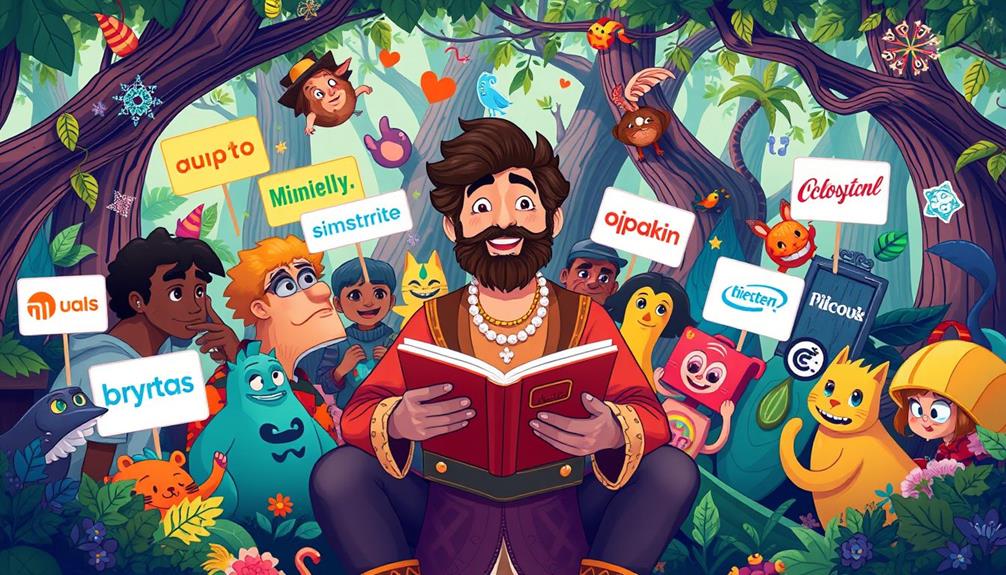Creative storytelling is essential for making your brand iconic. It helps you connect emotionally with your audience, fostering loyalty and trust. By sharing authentic narratives that reflect your core values, you engage consumers on a deeper level. Successful brands like Apple and Nike showcase the power of compelling stories. To stand out, use universal character archetypes and involve your customers in the narrative. This participation not only amplifies your brand voice, but it also strengthens community ties. With effective strategies, you can measure your storytelling impact and adapt to audience feedback. Want to discover more about elevating your brand?
Key Takeaways
- Authentic storytelling fosters trust and emotional connections, essential for building a loyal customer base and an iconic brand.
- Utilizing universal character archetypes enhances relatability, allowing audiences to emotionally invest in your brand's narrative.
- Engaging customers in the storytelling process creates community and amplifies brand voice, making the brand more memorable.
- Consistent messaging across platforms reinforces authenticity and builds credibility, crucial for standing out in a saturated marketplace.
- Regularly assessing audience feedback and adapting narratives ensures your storytelling evolves and remains relevant to current consumer interests.
Importance of Brand Storytelling

Harnessing the power of storytelling, brand storytelling plays an essential role in connecting with your audience on an emotional level. When you craft a compelling brand storytelling strategy, you engage your audience in a way that fosters loyalty and builds a lasting connection. This isn't just about selling a product; it's about weaving narratives that reflect your core values and resonate deeply with consumers.
Successful brands like Apple and Nike show how effective storytelling can differentiate you in a crowded market. They convey their values not just through ads but through powerful stories that engage emotions and spark connections. By consistently reinforcing your core values across all customer touchpoints, you establish a strong brand identity that your audience recognizes and trusts.
Moreover, emotional engagement through storytelling activates specific brain areas tied to feelings, enhancing audience retention and loyalty. When your stories educate and entertain, they become memorable, setting you apart from your competitors.
In today's marketing landscape, brand storytelling isn't just an option; it's a necessity for creating meaningful connections that drive long-term success.
Elements of Effective Storytelling

When crafting your brand story, authenticity is key to building trust with your audience.
By embracing philosophical exploration in your narratives, you can uncover deeper meanings that resonate emotionally, making your message more impactful.
Additionally, involving customers in the storytelling process can foster a sense of community and participation that truly amplifies your brand's voice.
Authenticity Builds Trust
Authenticity plays an essential role in building trust, as consumers gravitate towards brands that share genuine stories reflecting their core values and beliefs. When you prioritize authenticity in your brand storytelling, you create a narrative that resonates with your audience.
To achieve this, it's important to communicate your core values consistently across all touchpoints, reinforcing your brand's identity and making it relatable. Additionally, incorporating design thinking principles can enhance your storytelling by emphasizing user-centric solutions and fostering a deeper emotional connection with your audience.
Transparency is another significant element. By being open about your practices—such as providing clear product descriptions and demonstrating ethical behavior—you cultivate trust among consumers who are often skeptical in today's marketplace.
Authentic storytelling helps counteract misinformation and the allure of social media perfection, allowing you to establish credibility through relatable narratives.
Moreover, engaging stories rooted in authenticity foster deeper connections with your audience, nurturing long-term loyalty. When people see that your brand stands by its values, they're more likely to engage and form lasting relationships.
Ultimately, by focusing on authenticity in your brand storytelling, you create an environment where trust flourishes, setting the stage for your brand to stand out in a crowded landscape.
Emotional Resonance Matters
Emotional resonance is the heartbeat of effective storytelling, drawing audiences in and forging connections that go beyond superficial interactions. When you tap into this emotional depth, your brand strategy transforms, fostering loyalty and engagement that cold facts simply can't achieve.
By crafting narratives that resonate with your audience, you create memorable experiences that stick. In the world of marketing, understanding your audience's emotional triggers can markedly enhance engagement, much like how family photoshoot fails often evoke laughter and connection through relatable experiences.
To enhance emotional resonance in your storytelling, consider these key elements:
- Authentic Narratives: Communicate your core values through genuine stories to build trust and credibility.
- Universal Character Archetypes: Use familiar characters to enhance relatability, allowing audiences to see themselves in your narrative.
- Engaging Storytelling: Focus on compelling plots that evoke emotions, making your brand more memorable.
- Shared Experiences: Create opportunities for your audience to connect with your brand's story, fostering a sense of community.
Engage Through Participation
Storytelling becomes truly powerful when it invites your audience to step into the narrative. When you engage through participation, you turn your audience from passive observers into active contributors, creating a sense of community and connection that boosts brand loyalty.
By involving customers and employees in the storytelling process, you craft a collaborative narrative that resonates more deeply with everyone.
Utilizing universal character archetypes in your storytelling makes it relatable, encouraging emotional investment and participation. This connection allows your audience to see themselves in your story, fostering a stronger bond with your brand.
Addressing social and environmental issues through your narratives not only enhances relevance but also inspires meaningful engagement.
Your brand stories should spark inspiration, inviting your audience to share their experiences and insights. When they feel a part of the journey, they're more likely to advocate for your brand and contribute to its evolution.
Strategies for Successful Storytelling

Crafting compelling narratives requires a strategic approach that resonates with your audience. To create an impactful brand story, you should consider these effective storytelling strategies:
- Utilize universal character archetypes: This enhances relatability and creates a deeper emotional connection with your audience. For instance, the journey of celebrities like Caleb Coffee, who survived a 60-80 foot cliff fall exemplifies resilience and can inspire your brand's narrative.
- Develop signature stories: Highlight your unique brand attributes to make your narrative memorable and engaging for consumers.
- Test your storytelling methods: Start on a smaller scale before a full-scale launch to guarantee your story effectively resonates with your target audience.
- Involve customers and employees: Their real experiences help create authentic narratives that foster trust and connection.
Overcoming Storytelling Challenges

Steering through the complexities of brand narratives can be intimidating, but overcoming storytelling challenges is vital for maintaining audience engagement.
To keep your storytelling relevant, you must actively maintain and evolve your brand story even after it's approved. Stagnation can lead to audience disinterest, so adapt your narrative to reflect current trends and consumer interests. Implementing strategies from effective keyword research can help you better understand what resonates with your audience and refine your storytelling approach.
In a saturated marketplace, differentiating your brand through storytelling is essential. A unique brand identity helps you stand out, ensuring your audience can easily recognize and connect with you.
Consistent messaging across all platforms reinforces your brand identity and builds customer trust, so avoid mixed signals that could confuse your audience.
Don't forget to regularly assess and refine your storytelling strategies based on audience feedback. This alignment with consumer expectations will help you remain relevant.
Additionally, leverage successful storytelling campaigns as benchmarks. By identifying effective techniques, you can improve your future marketing efforts and keep your brand story engaging.
Measuring Storytelling Impact

How can you truly know if your brand's story is making an impact? Measuring storytelling effectiveness involves a mix of metrics and feedback that reveal how well your brand story resonates with your audience.
Here are some key areas to focus on:
- Audience Engagement: Track likes, shares, and comments to assess how your storytelling strategies are performing.
- Brand Loyalty: Analyze repeat purchases and customer retention rates to understand the long-term effects of your storytelling on consumer relationships.
- Social Media Sentiment: Monitor interactions and conduct sentiment analysis to see how well your brand story resonates, pinpointing areas for improvement.
- Consumer Perception: Use surveys or focus groups to evaluate shifts in attitudes and preferences after your storytelling initiatives.
Exemplary Brands and Their Successes

Several brands have mastered the art of storytelling, effectively connecting with their audiences and driving success. Paynter Jacket stands out by creating anticipation through insider access, emphasizing sustainability and quality. This narrative not only engages customers but also builds a community around shared values. Similarly, BYBI Beauty showcases its commitment to natural and vegan ingredients, appealing to eco-conscious consumers through authentic storytelling.
Both brands illustrate how compelling narratives can drive engagement and boost sales, proving that authenticity is key in brand storytelling.
| Brand | Storytelling Focus | Success Outcome |
|---|---|---|
| Paynter Jacket | Insider access, sustainability | Strong community engagement |
| BYBI Beauty | Natural ingredients, eco-friendliness | Increased consumer loyalty |
| Both | Authenticity and connection | Enhanced brand recognition |
Paynter's growth from a beauty blog to a thriving brand is a demonstration of a strong narrative that champions female entrepreneurship. Meanwhile, BYBI's use of recyclable packaging aligns with its ethos, reinforcing its storytelling success. These exemplary brands show that a powerful story can transform a brand into an iconic player in its market.
Frequently Asked Questions
How Do You Build a Brand Through Storytelling?
To build a brand through storytelling, start by defining your brand's purpose and core values.
Make certain these values shine through in every narrative you share.
Create engaging, emotional stories that invite your audience to connect with your journey.
Use relatable characters and unique elements that highlight what sets you apart.
Regularly seek feedback to refine your approach, and measure engagement to guarantee your stories resonate and evolve with your audience.
How Is Storytelling Used to Strengthen a Brand?
Storytelling's like a bridge connecting you to your audience, strengthening your brand in the process.
When you share authentic narratives, you create emotional connections that foster loyalty beyond mere transactions.
By using universal character archetypes, your audience can see themselves in your story, enhancing engagement.
Plus, as you measure audience reactions, you can refine your narratives, ensuring they resonate and build trust, making your brand more relatable and memorable.
What Is the Role of Storytelling in Brand Building?
Storytelling plays an essential role in brand building by creating emotional connections with your audience.
When you share authentic narratives that reflect your brand's values, you foster trust and credibility. This engagement goes beyond transactions, making customers feel part of your journey.
By using relatable characters and scenarios, your stories resonate more deeply, encouraging loyalty.
Ultimately, effective storytelling distinguishes you in a crowded market, helping your brand become memorable and impactful.
What Are the Essentials of Brand Storytelling?
When you think about brand storytelling, picture a campfire gathering where everyone's engaged, sharing tales that resonate.
The essentials of effective brand storytelling include authenticity, emotional connection, and clarity. You want your audience to feel your brand's true values.
Use relatable characters and consistent messaging across all platforms to reinforce your identity. By inviting participation and aligning with audience expectations, you'll transform customers into passionate advocates who deeply connect with your brand's narrative.
Conclusion
Just like a masterful bard weaving tales around a crackling fire, your brand's story can captivate hearts and minds. By embracing the art of storytelling, you're not just selling a product; you're inviting your audience on an unforgettable journey. Remember, every great tale has its trials and triumphs. So, embrace the quest, share your narrative, and watch your brand shine like a star in the night sky, leaving a lasting impression on all who encounter it.









